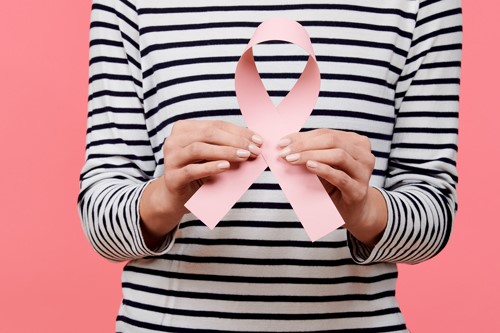Early detection is your best protection

“The biopsy was positive for breast cancer.” Dr Bergin gently shared the news with me in the outpatient surgery unit that day. My mammogram and follow up imaging had shown some distortion of uncertain status, and further evaluation had been recommended. I didn’t have any family history of breast or other GYN cancers, but was aware that statistically, one in eight women will experience breast cancer in her lifetime. Now, at age 54, I had just “joined” a Sisterhood of women with breast cancer.
The numbers are huge. Breast cancer is the most commonly diagnosed non-skin cancer in American women, and is expected to make up about 30% of all new cancers diagnosed in 2021. The majority of women diagnosed with breast cancer, about 85%, will be like me—no family history of breast cancer. Our cancers occur due to spontaneous genetic changes over time, not inherited genetic issues, with the majority of cases occurring over age 50. However, family history of breast cancer is associated with increased risk for developing breast cancer, and risk may be significantly higher if gene mutations are inherited. BRCA1 and BRCA2 are the most common genetic mutations and may increase risk for breast cancer and ovarian cancer by nearly 70%. Women with these mutations tend to develop cancer at younger ages. Men who carry these mutations also have risk for breast cancer. Overall, breast cancer is the number 2 cause of cancer deaths in women, second only to lung cancer.
So that’s the bad news. The good news is that the survival rates for breast cancer have improved significantly over time. While large numbers of women continue to be diagnosed with breast cancer, early detection and extensive scientific research and development of treatment options have significantly decreased the percentage of women who die as a result of their cancer. Early detection remains the most effective factor, and the technology available for diagnosis has also continued to improve. Most women at normal risk will be advised to start routine screening mammograms between ages of 40 to 50. Additional imaging such as ultrasound or MRI may be recommended at times. Women with family history of breast or ovarian cancer should talk with their primary care provider about a plan for risk management, which may include options such as starting mammograms at a younger age and referral to a specialist for genetic testing and monitoring.
Essentially, the best treatment for breast cancer is early detection, and the primary requirement is show for those routine evaluations on a regular basis. When life is busy, or a bit crazy as it has been with recent Covid 19 pandemic, routine maintenance can sometimes be put on the back burner of life as low priority events. However, those “routine” evaluations are where problems can be identified in early stages when effective treatment options are available. Delayed health evaluations are often associated with more advanced disease at time of diagnosis, and poorer long-term outcomes.
When I joined the Sisterhood of women with breast cancer, I was also fortunate enough to also join another group—the Fellowship of cancer survivors of all kinds, including men and women. My breast cancer diagnosis came 12 years ago, and I am grateful that my early diagnosis allowed me to have effective treatment and move on with my life. I want others to be as fortunate as I have been. The first step for most of us is to get that recommended “routine” evaluation, whether it is a mammogram, colonoscopy, or annual exam. You just need to show up.
October is National Breast Cancer Awareness Month and the Sidney Health Center mammography staff is offering evening mammograms to increase access to this important screening. I you are 40 years or older, you can schedule a screening mammogram without a referral by calling the Sidney Health Center outpatient coordinator at 406.488.2195.
